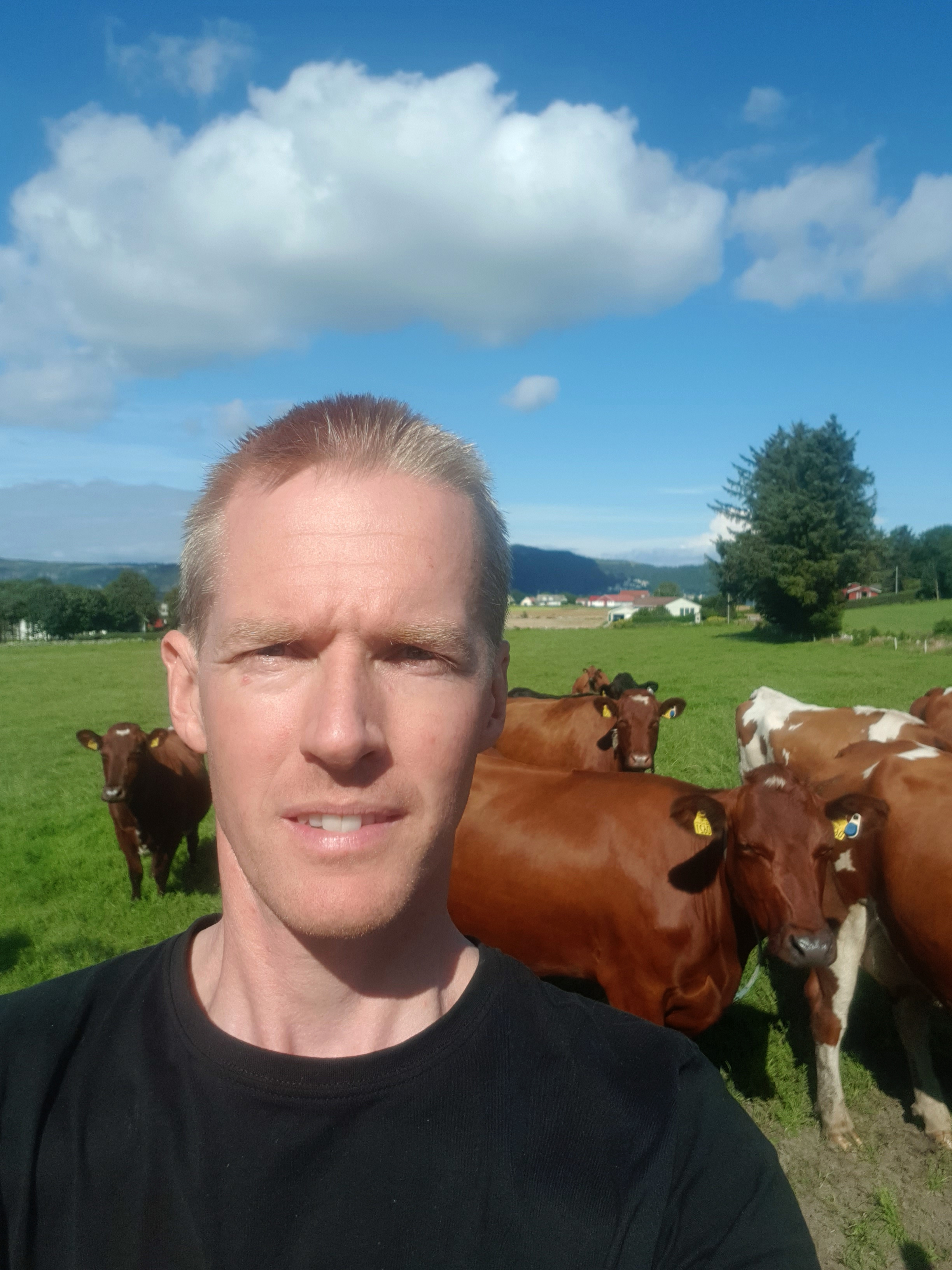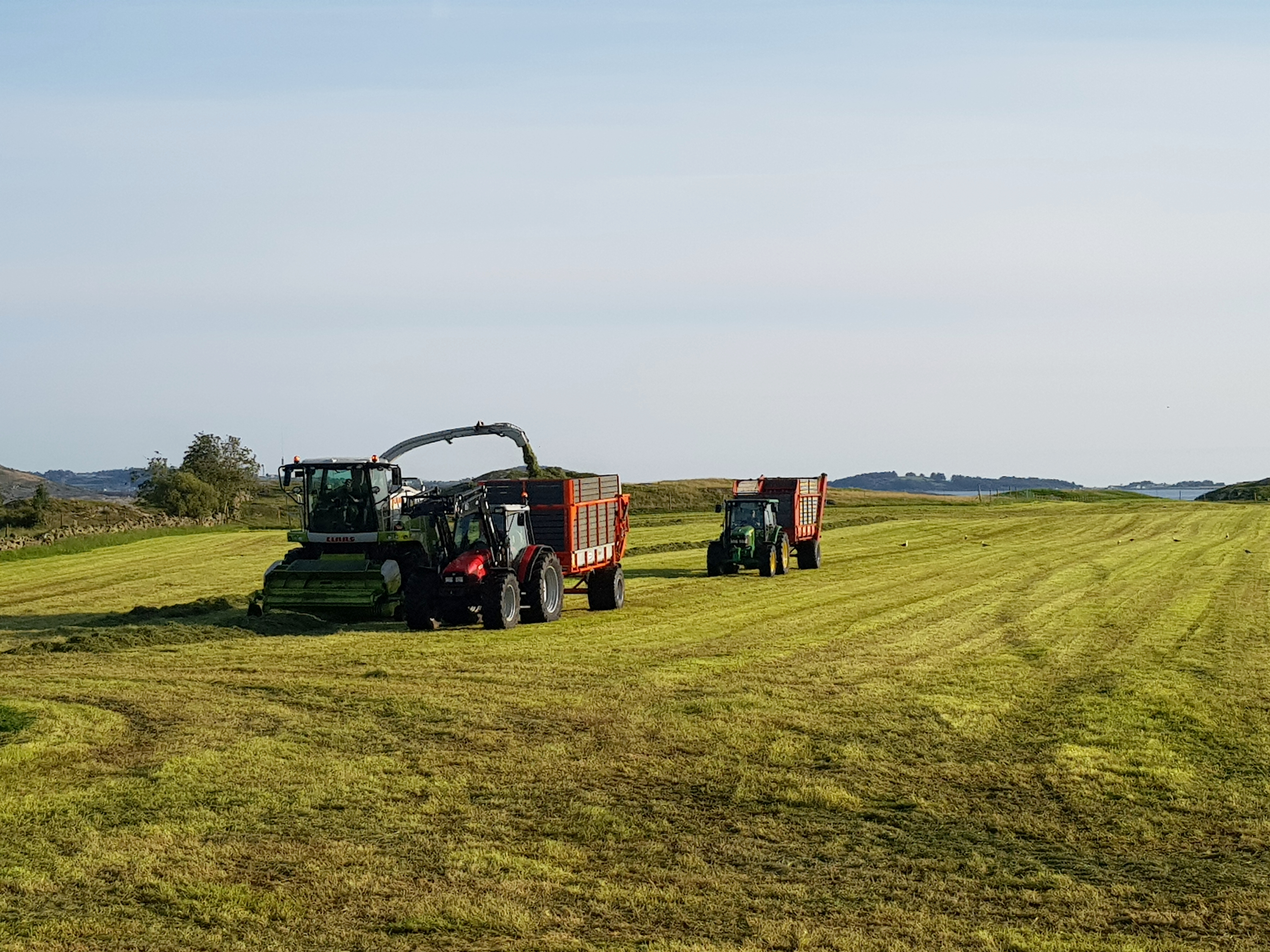

Karl Olav Hodnefjell out on the pasture by the cows on a nice sunny day. (photo: Karl Olav Hodnefjell)
- The best thing about being a farmer is getting to work with animals. I get to do physical work and be outdoors. I like to manage my days by myself and be my own boss. It's nice when the animals are grazing!
That's what Karl Olav Hodnefjell says, who has taken over the family farm at Hodnefjell. He thinks that spring is a great time with lambing, calving and brighter days. For Karl Olav, there was never any doubt that he would be the one to take over the farm.
- I grew up on the farm and as I was the oldest, I had allodial rights to the farm. I had a nice childhood. We were five siblings and had good company with each other. On the farm we were allowed to work with whatever we wanted and there was never any forced labor. I've been interested in the farm from the start, says Karl Olav.
A typical work day for Karl Olav starts with tending in the barn.
- I get a lot of help from my dad in the morning. That way I can drive the kids and deliver them at the kindergarden. When I get home, I start work on what needs to be done that day - and that varies with the seasons. Later I go back to pick the kids up from the kindergarden again, when it's my turn to pick them up. Lastly, it's back in the barn to tend to the livestock again before night time, says Karl Olav.
A few weekends ago we harvested the 2nd cut of grass of the year. At Hodnefjell, the proccess consists of fine cutting and storing the grass in a silo, while some is pressed into round bales. We have had another round of fertilizing and are doing pasture cleaning. The 3rd grass harvest is closing in - for everyone in the family.
Karl Olav's 90 winter-fed sheep get about 210 lambs. Some of them end up as bottle lambs, and there will always be some losses. Each year, they take care of 20 of the lambs for further production, which are mated when the time is right.

From the spring lambing, where the children got to meet the little lambs. (photo: Karl Olav Hodnefjell)
- On Friday we weighed and selected which lambs to send for slaughter. Next we have to separate the sheep from the lambs in two separate pastures, preferably with some distance between them. This usually goes without any problems but it does take a full work day to do. The first 24 hours apart there can be a lot of rutting. They shout for each other. But it calms down quickly, says Karl Olav.
When Karl Olav weighs the lambs, he chooses the ones that are at least 50 kg to maximize the price from slaughter. Those who have not yet reached the desired weight must wait three weeks before the next shipment for slaughter. If they still have not reached 50 kg, then they have to eat up for another three weeks - but that applies to very few.
- We also have a quota for and deliver "niche lambs", called "klosterlam". They are exactly the desired weight; not too light nor too heavy. These must meet given requirements for both weight and class to be approved. They are sold at Norwegian "Rema 1000"-stores. We get paid better for a "niche product" than for a normal delivery of lamb, says Karl Olav.
Today, Karl Olav has stall barns on Hodnefjell. The biggest challenge he is facing is how the operational buildings are getting old. He must decide on the way forward. He is considering whether to invest anew and convert to an open housing solution, or to convert the operation to dairy. Shutting down is not an option.

Wife and two of their kids in the field, 3 ha of field corn to feed the livestock (photo: Karl Olav Hodnefjell)
- We are currently in a planning phase where we are considering our alternatives. It is difficult to comply with the new requirements that are coming in regards to open housing, sick pay and various other things. Prices have increased so much that we have to consider what can be done financially. We have to survive, says Karl Olav.
Karl Olav was an early adopter of Agrilogg - the Norwegian version of Agrinote - and he thinks it is a useful tool for managing the farm. He says it's easy to find everything and little time is spent looking for what he needs. That is positive! With Agrilogg, he can enter what he has done right away, before he forgets.
- I think that Agrilogg has developed well from the beginning to now. Agrilogg is a great logging tool to bring with you. I mostly use the modules for haying, fertilizing, spraying and soil cultivation. The spraying journal is a nice touch! And the module for machine maintenance. I use the notes module, where I also make various to-do lists. Another example of how I use it is to write down which settings I have on my machinery. That way I can track how well those fertilizer spreader settings did for that given yield goal - and I can choose whether to adjust for next year's production, says Karl Olav.
- There is nothing I miss in Agrilogg, not that I can think of.
We at Agrinote thank you for the conversation and wish Karl Olav Hodnefjell the best of luck with the farm!

The calves are enjoying themselves at the pasture (photo: Karl Olav Hodnefjell)

The children are helping to plant potatoes (photo: Karl Olav Hodnefjell)

In full swing with the second harvest (photo: Karl Olav Hodnefjell)

The oldest daughter, Vilde, keep two horses on the farm. (photo: Hedda Transeth)